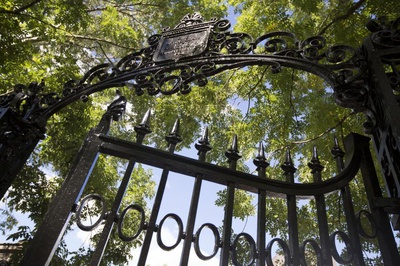
News
Harvard Grad Union Agrees To Bargain Without Ground Rules

News
Harvard Chabad Petitions to Change City Zoning Laws

News
Kestenbaum Files Opposition to Harvard’s Request for Documents

News
Harvard Agrees to a 1-Year $6 Million PILOT Agreement With the City of Cambridge

News
HUA Election Will Feature No Referenda or Survey Questions
Ringing the Lowell Bells: The ‘Great, Unfinalizable Symphony’

Writing a column about bell-ringing is, in a way, a hopeless endeavor. The experience is like taking a photocopy of a photocopy — the product takes you further from the art at hand, the lived experience. How can I convey in writing what the vibration of the bell feels like up there in the tower, what it feels like as the breeze off the Charles River numbs your fingers while you tap away at wires that physically connect bell-ringer to bell, and what it feels like to struggle with your fellow ringers to honor your inherited place in a centuries-old tradition without ever really knowing the people you inherited it from? I’m writing this column because I’d like to try.
The history of the Lowell Bells is fairly well-documented already, with articles and information on the Lowell House website and even published in the New Yorker. However, what I’m interested in documenting is not the bells themselves, but rather the process and experience of bell-ringing. I’ve been a Lowell Bell-Ringer for over a year now, ringing each week and participating in the bell exchange trip to Estonia and Finland to learn from traditional ringers. In that time, I’ve slowly fallen in love with the practice and principles of bell-ringing, while simultaneously understanding how strange and discordant the tradition might seem from the outside.
It’s painfully easy to get someone to hear the bells — just exist within a half-mile radius of the bell tower on Sundays at 1pm and you can’t escape it — yet very difficult to describe what’s going on inside the tower. In fact, it’s near-impossible to convey what being a true bell-ringer actually feels like.
For this column, I will be living and breathing bells — taking photographs, interviewing ringers, reflecting on peals, reminiscing about the bell exchange trip — anything to try to bridge that 128-step gap between the platform of the bell tower and the world below. This first installment will cover what it means, practically and metaphorically, to be a Lowell Bell-Ringer, based on personal reflections and conversations with Carly Y. Chen ’26 and Benjamin Walter ’26, Presidents of the Lowell House Society of Russian Bell-Ringers (or, informally, the “Klappermeisters”), as well as James Browning, bell-ringer and Harvard Ph.D. student in the Department of Slavic Languages and Literatures.
The Practice of Bell-Ringing

Bell-ringing is a concert of the limbs. The Lowell tower contains 17 bells, ranging in size and ringing technique. These include small bells called “trills” played with a set of ropes arranged like reins, a melody section played by pressing on wires arranged like a keyboard, stompers played by pulling chains below the platform or stomping on pedals above it, as well as the 13-ton “Mother Earth” played by swinging the heavy clapper with a large rope from within the bell itself. Traditionally, bell-ringing is a one-person practice, with a master bell-ringer coordinating several of those actions simultaneously to create a cohesive peal.
But one mere Harvard student can’t pull this off alone. Thus, to be a Lowell Bell-Ringer is to be one limb among many. In a given peal, you might be serving as the right arm pulling on the trills, while your fellow ringer is the left foot pressing on the stompers, and another is the heartbeat keeping time by ringing Mother Earth.
“It’s a really physical thing,” Walter said. “It’s unlike pretty much any instrument. You really have to heave and ho to do it. You do it with your whole body.”
“With the bells, there’s something very primal,” Browning said. “You recognize that it's just metal, and it’s air, and it's you, and you're connected to it.”
“The bells are physically majestic,” Chen, a Crimson editor, said. “They’re so big, and they’re literally loud! You can’t ignore them.”
Chen is right that they can’t be ignored, much to the chagrin of river house residents. To make matters worse, what the many unwitting listeners at Harvard don’t realize is that Russian bells aren’t like Western-style bells that play melodies. Instead, their style consists of rhythmic layered peals without specified notes, an experience that may be off-putting for listeners expecting to hear a typical church bell melody.
The Lowell bells are a unique blend of the two styles, being both Russian in origin and melodically tuned to a Western scale. Because of this combination, Lowell ringers can play a mix of traditional Russian rhythmic peals, contemporary pop melodies, and eclectic Lowell Bell-Ringer originals — a whiplash-inducing combination that may be appreciated only by those following along inside the tower.
The Resonance of Bell-Ringing

The bell is a noble metaphor. In Russian Orthodox tradition, bells represent the voice of God, and when you hear Mother Earth’s sonorous, omnipotent tone, it’s easy to understand why. Bells are cyclical — punctuating campus every Sunday at 1 p.m., in the case of the Lowell bells — yet they also symbolize linear time marching forward toward salvation as they play through religious holidays and mark special occasions.
“The beauty of a symbol like a bell, a sound symbol, is that you don't have a lot of intelligibility to it. It's all stuff that you map onto it,” Browning said.
Browning’s dissertation work involves a cultural and literary history of bell-ringing.
“The vibrations never really go away, they just diminish,” he said. “You're adding to the song that someone else played before you, and they're adding to the song that was played before them. You're picking up this piece that was started when the bell was first cast.”
Time feels suspended up in the bell tower. The bells produce the same sounds from the same metal that has rung in Lowell for decades, replicated from ones that rang for centuries before that. In that sense, we’re connected with so many predecessors we will never know, connected across time by sound and space.
“You're part of this great, unfinalizable symphony that everyone gets to participate in,” Browning said.
Being a bell-ringer can sometimes feel like a negotiation. We have so many contradictions passing through us when we ring: American pop melodies played on ornate Russian bells, the voice of God emanating out of a secular bell tower, our centuries-old traditions interspersed with refreshing comments on Sidechat, a profoundly meaningful experience that we know most of our listeners might never understand. Bell-ringing at Lowell means experiencing the ridiculous and the sacred all at the same time — in the same pull of a rope or press of a wire.

Stella A. Gilbert is a Harvard College junior concentrating in Sociology and Economics. Her column “For Whom The Bell Tolls” explores the tradition and experience of bell-ringing at Harvard and around the world through personal reflections, interviews, and photography. She can be reached at stella.gilbert@thecrimson.com.
Want to keep up with breaking news? Subscribe to our email newsletter.
From Our Advertisers

Over 300+ courses at prestigious colleges and universities in the US and UK are at your disposal.

With innovative financial tools combined with financial education, Collegiate empowers students to take control of their finances and build confidence in their money management skills.

Serve as a proctor for Harvard Summer School (HSS) students, either in the Secondary School Program (SSP), General Program (GP), or Pre-College Program.

With an increasingly competitive Law School admissions process, it's important to understand what makes an applicant stand out.

Welcome to your one-stop gifting destination for men and women—it's like your neighborhood holiday shop, but way cooler.

Admit Expert is a premium MBA admissions consulting company, helping candidates secure admission to top B-schools across the globe with significant scholarships.
